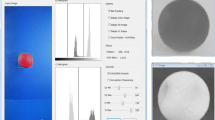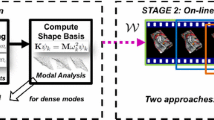Abstract
In this paper, we present a new method to estimate the mechanical parameters of soft bodies directly from videos of solids getting deformed under external user action. Our method requires one standard camera, a deformable solid made of homogeneous material, and a regular light source. We make estimations using an inverse method based on a quasi-static FEM simulation and a visual error metric. The result is a set of two parameters, the Young modulus and the Poisson ratio, that can be used for more complex simulations, or force feedback applications like virtual surgery, for example. We also present a new device for capturing the external forces applied on the deformable solids.
Similar content being viewed by others
References
Belytschko, T., Parimi, C.: Structured extended finite element methods for solids defined by implicit surfaces. Numer. Meth. Eng. 56, 609–635 (2003)
Benech, N., Negreira, C.A.: Longitudinal and lateral low frequency head wave analysis in soft media. J. Acoust. Soc. Am. 117(6), 3424–3431 (2005)
Duriez, C., Dubois, F., Andriot, C., Kheddar, A.: Realistic haptic rendering of interacting deformable objects in virtual environments. IEEE Trans. Vis. Comput. Graph. 12(1), 36–47 (2006)
Freeman, W.T., Adelson, E.H.: The design and use of steerable filters. IEEE Trans. Pattern Analysis Mach. Intell. 13, 891–906 (1991)
Hall, T.J., Bilgen, M., Insana, M.F., Krouskop, T.A.: Phantom materials for elastography. Ultrason. Ferroelectr. Freq. Control, IEEE Trans. 44(6), 1355–1365 (1997)
Kirkpatrick, G., Vecchi, O.: Optimization by simulated annealing. Science 220, 671–680 (1983)
Lang, J., Pai, D.K., Woodham, R.J.: Acquisition of elastic models for interactive simulation. Int. J. Robotic Res. 21(8), 713–734 (2002)
Miller, K., Chinzei, K.: Constitutive modeling of brain tissue: experiment and theory. J. Biomech. 30, 1115–1121 (1997)
Ostrander, L.E., Lee, B.Y.: Testing viscoelastic properties of biological soft tissue. Eng. Medicine Biol. Soc. 14, 107–109 (1992)
Pai, D., Lang, J., Lloyd, J., Woodham, R.: ACME, a telerobotic active measurement facility. Exp. Robotics VI 250, 391–400 (2000)
Samani, A., Bishop, J., Plewes, D.B.: A constrained modulus reconstruction technique for breast cancer assessment. IEEE Trans. Med. Imaging 20, 877–885 (2001)
Samani, A., Plewes, D.: An inverse problem solution for measuring the elastic modulus of intact ex vivo breast tissue tumours. Phys. Medicine Biol. 52(5), 1247–1260 (2007)
Soza, G., Grosso, R., Nimsky, C., Hastreiter, P., Fahlbusch, R., Greiner, G.: Determination of the elasticity parameters of brain tissue with combined simulation and registration. Int. J. Med. Robotics Comput. Assist. Surg. 1(3), 87–95 (2005)
Zhang, M., Zheng, Y.P., Mak, A.F.T.: Estimating the effective Young’s modulus of soft tissues from indentation tests—nonlinear finite element analysis of effects of friction and large deformation. Med. Eng. Phys. 19(6), 512–517 (1997)
Baraff, D., Witkin, A.: Large steps in cloth simulation. In: Proceedings of ACM SIGGRAPH 98, pp. 43–54. ACM Press (1998)
Becker, M., Teschner, M.: Robust and efficient estimation of elasticity parameters using the linear finite element method. In: Proceedings of Simulation and Visualization, pp. 15–28. Magdeburg, Germany (2007)
Bhat, K., Twigg, C., Hodgins, J., Khosla, P., Popovic, Z., Seitz, S.: Estimating cloth simulation parameters from video. In: Proceedings of ACM SIGGRAPH/Eurographics Symposium on Computer Animation (SCA 2003), pp. 37–51. ACM Press (2003)
Boivin, S., Gagalowicz, A.: Image-based rendering of diffuse, specular and glossy surfaces from a single image. In: Proceedings of the 28th annual conference on Computer graphics and interactive techniques, pp. 107–116. ACM Press (2001)
Bruyns, C., Ottensmeyer, M.P.: Measurements of soft-tissue mechanical properties to support development of a physically based virtual animal model. In: MICCAI ’02: Proceedings of the 5th International Conference on Medical Image Computing and Computer-Assisted Intervention—Part I, pp. 282–289. Springer, London (2002)
Chen, E.J., Novakofski, J., Jenkins, W.K., O’Brien, Jr. W.D.: Young’s modulus measurements of soft tissues with application to elasticity imaging. Ultrason. Ferroelectr. Freq. Control, IEEE Trans. 43(1), 191–194 (1996)
Delalleau, A., Josse, G., Lagarde, J.M., Zahouani, H., Bergheau, J.M.: Characterization of the mechanical properties of skin by inverse analysis combined with the indentation test. J. Biomech. 39, 1603–1610 (2006)
Kauer, M., Vuskovic, V., Dual, J., Szekely, G., Bajka, M.: Inverse finite element characterization of soft tissues. In: MICCAI ’01: Proceedings of the 4th International Conference on Medical Image Computing and Computer-Assisted Intervention, pp. 128–136. Springer, London (2001)
Liu, H., Shi, P.: Meshfree particle method. In: ICCV ’03: Proceedings of the Ninth IEEE International Conference on Computer Vision, pp. 289–296. IEEE Computer Society, Washington (2003)
Yu, Y., Debevec, P., Malik, J., Hawkins, T.: Inverse global illumination: recovering reflectance models of real scenes from photographs. In: Proceedings of ACM SIGGRAPH, pp. 215–224 (1999)
Revell, J.: Computer vision elastography. PhD Thesis, Computer Science, University of Bristol (2005)
ARToolKit. http://www.hitl.washington.edu/projects/shared_space/
Ascension Technology Corporation. Flock of birds. http://www.ascension-tech.com/products/flockofbirds.php
Hewlett Packard. MP-3130 Video Projector. http://h10032.www1.hp.com/ctg/Manual/c00063469.pdf
Instron. Universal Materials Testing Machines. http://www.instron.us/wa/products/universal_material
SCAIME. K1107 force sensor. http://www.scaime.com/Acrobat3/force/FT-K1107-FE-0999.pdf
SensAble Technologies. Phantom series. http://www.sensable.com/products-haptic-devices.htm
Smooth-On. Ecoflex Liquid Rubber. http://www.smooth-on.com/liqrubr.htm
SONY. Handycam DCR-TRV950E. http://www.sony.fr/view/ShowProduct.action?product=DCR-TRV950E
Vicon. Motion capture systems. http://www.vicon.com/
Zwick. Universal hardness tester. http://www.globalspec.com/FeaturedProducts/Detail/ZwickUSA
Author information
Authors and Affiliations
Corresponding author
Rights and permissions
About this article
Cite this article
Syllebranque, C., Boivin, S. Estimation of mechanical parameters of deformable solids from videos. TVC 24, 963–972 (2008). https://doi.org/10.1007/s00371-008-0273-5
Published:
Issue Date:
DOI: https://doi.org/10.1007/s00371-008-0273-5




